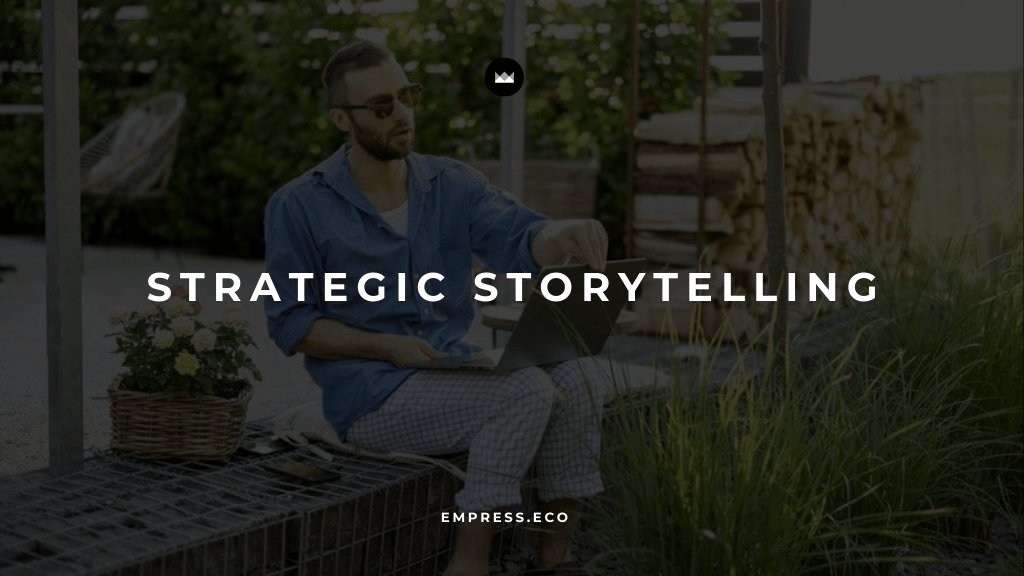
Empowering Premier Brands to Drive Client Engagement Through Strategic Storytelling
Build lasting client relationships by weaving stories that resonate and inspire action.
Table of Contents
Think about the last brand you felt connected to—the kind that made you not only want to buy from them but also recommend them to everyone you know. Chances are, it wasn’t just because of the product or service. It was because of the story. The way the brand communicated its purpose, its values, and how it made you feel like a part of something bigger.
That’s the power of strategic storytelling. In today’s saturated market, it’s no longer enough to simply offer a high-quality product or service. To truly engage your clients, build lasting relationships, and stand out in your industry, you need to tell a compelling story. And that’s where BLOOM by EMPRESS comes in. We help premier brands craft and execute storytelling strategies that resonate deeply with their audiences and drive real engagement.
In this blog, we’re going to explore how storytelling can empower your brand to build meaningful connections, increase engagement, and foster long-term loyalty. We’ll cover actionable insights on how to create a powerful brand narrative, how to weave storytelling across different channels, and why authenticity is crucial to client retention.
Why Storytelling is Essential for Client Engagement
Before we get into the “how,” let’s talk about the “why.” Why is storytelling so powerful when it comes to engaging clients? It’s simple: stories are how we relate to the world. They make complex ideas relatable, evoke emotion, and, most importantly, they stick. In fact, stories are 22 times more memorable than facts alone.
For premier brands, storytelling isn’t just a nice-to-have—it’s essential. Today’s consumers are savvy, and they’re not just looking for a product or service. They want to feel connected to the brands they support. They want to know your brand’s purpose, values, and vision. When done right, storytelling builds trust, creates emotional connections, and inspires action.
The Emotional Power of Stories
Storytelling taps into emotions, and emotions drive decisions. Whether your clients realize it or not, their buying decisions are often based on how they feel about your brand, not just the features of your product. A good story has the ability to evoke emotions that make people more likely to trust, engage with, and remain loyal to your brand.
Example: Consider the storytelling strategy of Apple. While their products are known for their sleek design and innovative technology, their brand narrative centers around the idea of creativity, innovation, and challenging the status quo. Apple doesn’t just sell devices—they sell the idea that using Apple products makes you a part of something bigger: a community of creators and innovators. This emotional connection is what keeps clients coming back, year after year.
Actionable Insight: Think about the emotional response you want your clients to have when they engage with your brand. Is it a sense of belonging? Empowerment? Excitement? Use your story to evoke those emotions and create a deeper connection with your audience.
1. Crafting a Compelling Brand Narrative: The Heart of Your Story
Every great story has a narrative arc, and the same goes for your brand. Your narrative is the foundation of all your storytelling efforts—it’s what ties everything together. It’s not just about the products or services you offer. It’s about the journey you’re inviting your clients to be a part of.
Identify Your Brand’s “Why”
To craft a compelling narrative, start by identifying your brand’s “why.” Why do you do what you do? What’s the bigger mission behind your brand? Clients are more likely to engage with brands that have a clear purpose and vision that align with their own values.
Example: Look at TOMS Shoes. Their brand narrative is built around the “One for One” model, where for every pair of shoes purchased, another is donated to someone in need. Their story isn’t just about selling shoes—it’s about giving back and making a positive impact in the world. This purpose-driven narrative has created a loyal community of clients who feel like they’re part of a movement, not just a transaction.
Actionable Insight: Take time to define your brand’s purpose. What’s the impact you want to have on your clients or the world? This purpose should be at the core of your brand narrative and communicated consistently across all touchpoints.
Make Your Client the Hero
In effective brand storytelling, your client isn’t just an audience—they’re the hero of the story. Your brand’s role is to guide them toward success, happiness, or whatever outcome they’re seeking. This client-centric approach makes your story relatable and relevant.
Example: Nike’s “Just Do It” campaign is a perfect example of this. The story isn’t about Nike’s products—it’s about the people who wear them and push themselves to achieve greatness. The athletes, the weekend warriors, the everyday people striving to be their best selves. Nike is the guide, the enabler, but the client is the hero.
Actionable Insight: Think about how your product or service helps your clients achieve their goals. Position your brand as the guide that empowers them to be the best version of themselves. Your narrative should focus on how you solve their problems or enhance their lives.
2. Telling Your Story Across Multiple Channels: Consistency is Key
Once you’ve crafted your core narrative, the next step is to tell your story consistently across multiple channels. Today’s clients engage with brands in a variety of ways—through social media, email, websites, and even in-person interactions. To build trust and create a cohesive brand experience, your story needs to be the same no matter where your clients encounter you.
Website Storytelling
Your website is often the first point of contact for potential clients, making it one of the most important platforms for your storytelling efforts. Your website should not only showcase your products but also clearly communicate your brand’s narrative and values.
Example: Warby Parker does a fantastic job of telling their brand story on their website. Their “About Us” page highlights their mission to offer affordable, stylish eyewear while giving back to the community. This story is woven throughout their product descriptions, blog posts, and even their checkout process, creating a consistent and engaging experience for visitors.
Actionable Insight: Review your website content and ensure your brand’s story is front and center. Make sure every page—whether it’s your homepage, About Us page, or product pages—reinforces your core narrative.
Social Media Storytelling
Social media offers a unique opportunity to engage with clients in a more personal, conversational way. It’s not just a platform to promote products—it’s a place to share your story, connect with your audience, and build a community.
Example: Glossier, a beauty brand, has mastered the art of storytelling on Instagram. Rather than focusing solely on products, they share stories from their customers, behind-the-scenes content from their team, and user-generated content that reflects their community’s experiences with the brand. This approach humanizes the brand and makes their audience feel like they’re part of the story.
Actionable Insight: Use social media to tell stories that showcase the human side of your brand. Share user-generated content, behind-the-scenes looks, or highlight customer success stories that align with your brand’s values. Make your audience feel like they’re part of the conversation.
3. Building Trust Through Authenticity and Transparency
In the digital age, clients have access to more information than ever before, and they can spot inauthenticity from a mile away. That’s why authenticity is key to building lasting relationships. When your storytelling is authentic, it builds trust. And trust is the foundation of long-term client engagement.
Share the Real Story
Clients want to know who you really are—flaws and all. It’s tempting to only share the polished, success-oriented version of your brand’s story, but sharing challenges and setbacks can be just as powerful. It shows clients that you’re human and that you’re willing to be open and transparent.
Example: Ben & Jerry’s is known for being open about their values, challenges, and even mistakes. When they launched their “Save Our Swirled” campaign to raise awareness about climate change, they were upfront about the difficulties they faced as a company in reducing their own carbon footprint. This honesty not only aligned with their brand’s social mission but also deepened the trust clients had in their commitment to making a difference.
Actionable Insight: Don’t shy away from sharing the ups and downs of your brand’s journey. Whether it’s a challenge you’ve overcome or a lesson you’ve learned, clients appreciate authenticity. It makes your brand more relatable and trustworthy.
4. Engaging Clients for the Long Term: Retention Through Storytelling
Storytelling isn’t just a tool for attracting new clients—it’s also essential for client retention. The brands that keep clients engaged over the long term are the ones that continue to tell stories that resonate, even after the sale is made.
Share Customer Success Stories
One of the most powerful forms of storytelling is sharing customer success stories. These real-life examples show potential clients the tangible benefits of your product or service while reinforcing your brand’s value to existing clients. Plus, they serve as social proof, helping to build credibility.
Example: Peloton regularly shares stories from their community of riders, highlighting how their equipment and programs have helped people transform their fitness journeys. This not only engages current users but also inspires new ones to join the Peloton family.
Actionable Insight: Gather testimonials and success stories from your clients. Share these stories on your website, social media, and email campaigns to showcase the real-world impact your brand has had. This not only helps with retention but also serves as social proof for new clients.
Keep the Story Going Post-Purchase
Storytelling shouldn’t stop after the sale. Keep your clients engaged by continuing to share stories that are relevant to them. This could include product updates, personalized tips, or behind-the-scenes content that gives them a deeper connection to your brand.
Actionable Insight: Create post-purchase email sequences that continue the storytelling journey. For example, if a client buys a product, follow up with an email that tells the story of how that product was developed or provides tips on how to use it effectively. This helps keep clients engaged long after the sale.
Conclusion: Drive Client Engagement with Strategic Storytelling Through BLOOM by EMPRESS
Storytelling is one of the most powerful tools for building deep, meaningful client engagement. When done right, it creates connections that go beyond the transactional, fostering long-term relationships that keep clients coming back for more.
At BLOOM by EMPRESS, we specialize in helping premier brands craft and execute storytelling strategies that resonate with their audiences and drive real engagement. Whether you’re looking to build a brand narrative from scratch or refine your existing storytelling approach, we’re here to help you unlock the full potential of storytelling.
By mastering the art of storytelling, your brand will not only engage clients more effectively but also build the kind of trust and loyalty that leads to long-term success. Let’s craft stories that make a lasting impact.
Ready to drive client engagement through the power of storytelling? Contact BLOOM by EMPRESS today and let’s create stories that inspire and connect.
Empress Newsletter
Join the newsletter to receive the latest updates in your inbox.



